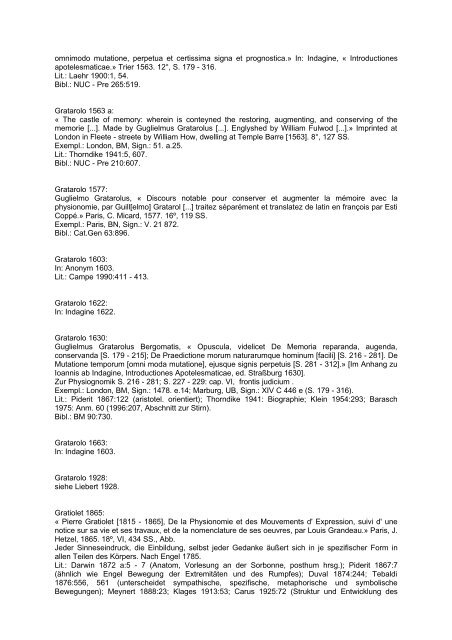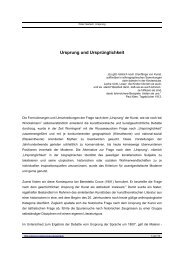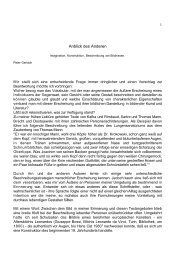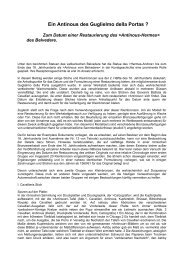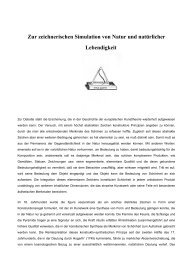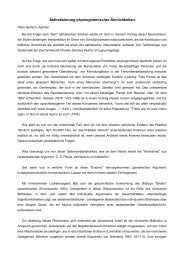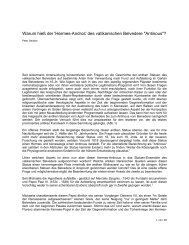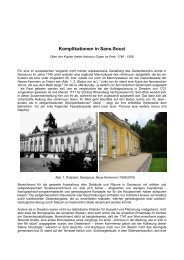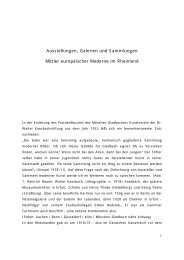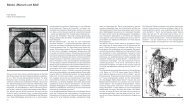- Seite 1 und 2:
Bibliographie von Texten zur Physio
- Seite 3 und 4:
compertae inque lucem productae [..
- Seite 5 und 6:
Bologna, per Hieronymus de Benedict
- Seite 7 und 8:
Adamantius Sophista, « Physiognomo
- Seite 9 und 10:
Gratiadio Machati [= ps. von Giovan
- Seite 11 und 12:
« Heinrich Cornelius Agrippa' s vo
- Seite 13 und 14:
Druck: Basel, apud H. Petrum, 1536.
- Seite 15 und 16:
Bibl.: BM 2:1269. Albertus 1490: Al
- Seite 17 und 18:
Bd. 54, Genf, Droz, 1967, S. 89 - 1
- Seite 19 und 20:
ISBN 3 - 631 - 34 184 - 9. Referat
- Seite 21 und 22:
Anonym 1465: Iathromathematisches H
- Seite 23 und 24:
« Phisionomei. Komplexion vnd, art
- Seite 25 und 26:
Bibl.: nicht nachweisbar. Anonym 15
- Seite 27 und 28:
Vgl. Sicler 1666. Lit.: Campe 1996
- Seite 29 und 30:
Lit.: Laehr 1900:2, 756 (3 Theile),
- Seite 31 und 32:
Anonym 1826: « Physiognomy, or the
- Seite 33 und 34:
Resultat der Flagellanten-Tradition
- Seite 35 und 36:
Exempl.: Berlin SB, Sign.: Vu.2023,
- Seite 37 und 38:
Alessandro sì per il reggimento de
- Seite 39 und 40:
148 SS., Abb. (Faksimile). Sammelba
- Seite 41 und 42:
Artemidorus 1864: « Artemidori Dal
- Seite 43 und 44:
Azaïs 1839: « Physiologie du bien
- Seite 45 und 46:
(descriptio scilicet, qualis possit
- Seite 47 und 48:
Exempl.: London, BM, Sign.: 87 09 k
- Seite 49 und 50:
Lit.: Courtine (1988) 1992:34, Anm.
- Seite 51 und 52:
Lit.: Paul Kirn, "Friedrich der Wei
- Seite 53 und 54:
Kriterien; Cleanthes, Petronius, Po
- Seite 55 und 56:
Baxandall 1964: Michael Baxandall,
- Seite 57 und 58:
Hans - Georg Behr, Herbert Grohmann
- Seite 59 und 60:
5 th edition.» London, R. Bentley,
- Seite 61 und 62:
Bibl.: Campe 1996:603; Cat.Gen 10:5
- Seite 63 und 64:
cura di Vittorio Casale, Treviso 19
- Seite 65 und 66:
« [...]. Avec les 30 portraits sup
- Seite 67 und 68:
Blanc 1860: Charles le Blanc, "Gram
- Seite 69 und 70:
Remo Bodei, « Geometria delle Pass
- Seite 71 und 72:
Bohn 1940: Hans Bohn, « Schwäbisc
- Seite 73 und 74:
Bordini 1989: Silvia Bordini, Il te
- Seite 75 und 76:
Boucher 1896: François Boucher, «
- Seite 77 und 78:
inc, Melanconicos tristes et graves
- Seite 79 und 80:
Amusing Tales, Illustrated with 19
- Seite 81 und 82:
Graphische Gesichts - Schemata, fro
- Seite 83 und 84:
Buffon 1749: Georges - Louis Lecler
- Seite 85 und 86:
Descartes, Bemerkungen von Parsons
- Seite 87 und 88:
Burton 1835: C. E. Burton, « Physi
- Seite 89 und 90:
donne, e del suo buono indrizzo lib
- Seite 91 und 92:
Rüdiger Campe, « Affekt und Ausdr
- Seite 93 und 94:
ezeichnet); Staum 1995:447 (umgeset
- Seite 95 und 96:
siehe Sarthe 1806, 1806 a. Camper 1
- Seite 97 und 98:
1965; Fierz 1977:32; Müller 1982:7
- Seite 99 und 100:
Flavio Caroli, "La Fisiognomia e il
- Seite 101 und 102:
Carracci 1730 a: « Livre de portra
- Seite 103 und 104:
Casoni 1557: Francesco Casoni, « D
- Seite 105 und 106:
Jean - Pierre Cèbe, « La Caricatu
- Seite 107 und 108:
Bibl.: Cat.Gen 27:139. Chastel 1983
- Seite 109 und 110:
Chiromantia 1480: « Ex diuina phil
- Seite 111 und 112:
Machine zur mechanischen Anfertigun
- Seite 113 und 114:
Ludwig Ferdinand Clauss, « Rasse u
- Seite 115 und 116:
Cocles 1525: siehe Tricasso, Veneti
- Seite 117 und 118:
Bibl.: Cat.Gen 30:387. Cocles 1551:
- Seite 119 und 120:
et delle donne, secondo l' opinione
- Seite 121 und 122:
Herrmann Conring [1606 Norden - 168
- Seite 123 und 124:
Andreas Corvus [de Morandola], » O
- Seite 125 und 126:
darin medizinischer Semiologie verg
- Seite 127 und 128:
Passionen gegenüber gemalten (S.33
- Seite 129 und 130:
Christoph Crusius, « Rerum crimina
- Seite 131 und 132:
Lit.: Alexis Bertrand, "L' art de c
- Seite 133 und 134:
1.Theil, Cap.1 "Welches sind die Ke
- Seite 135 und 136:
Lit.: Schmölders 1995:253. Bibl.:
- Seite 137 und 138:
Darwin 1872 a: « Der Ausdruck der
- Seite 139 und 140:
Bibl.: NUC 6:217. DeArte 1450: « D
- Seite 141 und 142:
DeLaForge 1669: « Tractatus de men
- Seite 143 und 144:
esprimi i suoi concetti più che la
- Seite 145 und 146:
DellaPorta 1588: Giovanni Battista
- Seite 147 und 148:
propentes naturalibus remediis comp
- Seite 149 und 150:
DellaPorta 1616: Giovanni Battista
- Seite 151 und 152:
Lit.: Hartley 1996:117, Anm. 24 (Pa
- Seite 153 und 154:
Bibl.: Bridson 1990:244, E 647; Gra
- Seite 155 und 156:
dell' edizione del 1610.» = Biblio
- Seite 157 und 158:
DeRubeis 1809: « De' Ritratti, oss
- Seite 159 und 160:
Descartes 1664 a: René Descartes
- Seite 161 und 162:
Denis Diderot, Eléments de physiol
- Seite 163 und 164:
vermischter Schriften zur Beförder
- Seite 165 und 166:
Es enthüllt inneren moralischen Zu
- Seite 167 und 168:
1969:20: Duchenne 1999:252, 255 (Na
- Seite 169 und 170:
der Anzeichen nach Körperteilen, s
- Seite 171 und 172:
Paris 1881. 336 SS., Abb. Bibl.: Ca
- Seite 173 und 174:
Bibl.: www.library.wellcome.ac.uk.
- Seite 175 und 176:
Joseph Engel, « Das Knochengerüst
- Seite 177 und 178:
Bibl.: DB 5:6714. Essik 1989: Rober
- Seite 179 und 180: Fabbri 1987 a: Paolo Fabbri - I. Pe
- Seite 181 und 182: Gemüther zu erkennen und zu regier
- Seite 183 und 184: Fess 1924: Gilbert Malcolm Fess, «
- Seite 185 und 186: Filippo Phinella, « De quatuor sig
- Seite 187 und 188: Ilsebill Barta Fliedl - Christoph G
- Seite 189 und 190: Psevdoaristotelis, graece et latine
- Seite 191 und 192: Fournel 1887: Victor L. Fournel, «
- Seite 193 und 194: Martini, Rhodio, Sperlingius, Wende
- Seite 195 und 196: Fuchs 1615: Samuel Cuslino Fuchs [F
- Seite 197 und 198: Galenus 1521: « Galeni Pergamensis
- Seite 199 und 200: Gall 1807: « Dr. F[ranz] J[oseph]
- Seite 201 und 202: Gall 1820: « Etwas über die Physi
- Seite 203 und 204: Gantrel 1700 a: Etienne Gantrel, «
- Seite 205 und 206: waren, auf der Loggia del Consiglio
- Seite 207 und 208: Gautier 1745: Jacques F. Gautier -
- Seite 209 und 210: Gerlach 1981: Peter Gerlach, "Ästh
- Seite 211 und 212: Ghiberti 1833: Lorenzo Ghiberti [13
- Seite 213 und 214: Sander L. Gilman, "Darwin sees the
- Seite 215 und 216: Konstruktion des Sokrates - Bildnis
- Seite 217 und 218: hoc est, De hominis perfectione, an
- Seite 219 und 220: Goclenius 1692: « R[udolf] G[oclen
- Seite 221 und 222: Goethe 1799: Johann Wolfgang von Go
- Seite 223 und 224: dt. in: « Meditationen über ein S
- Seite 225 und 226: Johann Christoph Gottsched [1700 -
- Seite 227 und 228: Bibl.: ZDB 62:D 18 (1961). Graham 1
- Seite 229: Untersuchung, als Reformierter floh
- Seite 233 und 234: Lit.: Clarke 1987:175, Anm. 15 (woh
- Seite 235 und 236: Groupe 1985: Groupe Mu (Liège), Fr
- Seite 237 und 238: Cassius Gurney, « How to Read the
- Seite 239 und 240: und Tucholsky - Heartfield Deutschl
- Seite 241 und 242: Metoposcopie und Chiromantie &c. Ge
- Seite 243 und 244: Hartlaub 1954: Gustav Hartlaub, "<
- Seite 245 und 246: Nach dem Text der Originalausgabe h
- Seite 247 und 248: Willy Hellpach, « Studien zur Ethn
- Seite 249 und 250: Bibl.: Heinsius 19,1:552. Hennert 1
- Seite 251 und 252: Geschichte der Physiognomik (hier:
- Seite 253 und 254: Hirdt 1970: Willi Hirdt, "Descripti
- Seite 255 und 256: abnehmen, auch das jahr, monat, woc
- Seite 257 und 258: Hogarth 1820: Siehe Sarthe 1820 (Li
- Seite 259 und 260: Exempl.: Siegen, UB, Sign.: S 21 K
- Seite 261 und 262: Chappvis [...].» Lyon, Francois Di
- Seite 263 und 264: Antonio Possevino [1534 - 1611]« C
- Seite 265 und 266: "Naturphysiognomik im alten Israel.
- Seite 267 und 268: Hyde 1884: Thomas A. Hyde, « How t
- Seite 269 und 270: Indagine 1543: [Johannes ab Indagin
- Seite 271 und 272: Lit.: Thorndike 1941:5, 66. Bibl.:
- Seite 273 und 274: Ingegneri 1606: Giovanni Ingegneri
- Seite 275 und 276: Jabet 1852: [George Jabet], « Note
- Seite 277 und 278: "Eine Poetik der Innerlichkeit." (S
- Seite 279 und 280: Hippokrates, Zopyros, Aristophanes,
- Seite 281 und 282:
1770). Lit.: Goclenius 1590; Rubens
- Seite 283 und 284:
B 270 - B 280, S. 295 - 302, hg. vo
- Seite 285 und 286:
ürgerliches Modell von Weiblichkei
- Seite 287 und 288:
Thomas Kirchner, Physiognomie als Z
- Seite 289 und 290:
Klages 1926 a: Ludwig Klages, "Prin
- Seite 291 und 292:
Knabe 1972: Peter - Eckhard Knabe,
- Seite 293 und 294:
Biblio Verlag, 1967. 4°, 35 , 65 S
- Seite 295 und 296:
Kristeva 1969: Julia Kristeva, "Le
- Seite 297 und 298:
Verunstaltetes Gesicht > Karikatur,
- Seite 299 und 300:
1664. Exempl.: Hannover, UB, Sign.:
- Seite 301 und 302:
Exempl.: London, BM, Sign.: 527. b.
- Seite 303 und 304:
Bibl.: Cat.Gen 84:894. LaBruyère 1
- Seite 305 und 306:
zwischen Tier und Mensch. Lit.: Car
- Seite 307 und 308:
London, W. Owen, 1749. 12°, 87 SS.
- Seite 309 und 310:
Vorstand der Orthopädischen Klinik
- Seite 311 und 312:
der Physiognomik." (S. 36); "Wie vi
- Seite 313 und 314:
(Kontinuitätsidee des Naturphiloso
- Seite 315 und 316:
hrsg. von Johann Michael Armbruster
- Seite 317 und 318:
Lit.: Laehr 1900:2, 941; Graham 196
- Seite 319 und 320:
Exempl.: London, BM, Sign.: 539. e.
- Seite 321 und 322:
existing between brute and human ph
- Seite 323 und 324:
« Essays on physiognomy; designed
- Seite 325 und 326:
Lavater 1858: Lavater 1847, 10. Auf
- Seite 327 und 328:
Lavater 1922: « Johann Caspar Lava
- Seite 329 und 330:
Lavaters analytische Anthropologie.
- Seite 331 und 332:
ist als Anatomie der Passionen zu l
- Seite 333 und 334:
Conférence sur l' expression de Pa
- Seite 335 und 336:
Lit.: Teyssèdre 1957:567, 677. LeB
- Seite 337 und 338:
[1730 ?]. 2°, II Bl., 19 Taf. [ 3
- Seite 339 und 340:
Lit.: Allentuck 1955:94 (Anonym ers
- Seite 341 und 342:
Schule, 15. bis 18. Jh., u. a. 24 Z
- Seite 343 und 344:
LeBrun 1807: siehe Lavater 1806 a,
- Seite 345 und 346:
of the History of Ideas. An interna
- Seite 347 und 348:
Lit.: AKL 5, 1992:602 (diese Ausgab
- Seite 349 und 350:
condammnation [...].» 2eme éd., P
- Seite 351 und 352:
Lenhossek 1824: Michael von Lenhoss
- Seite 353 und 354:
Firenze, u.a., Olschki, Bd. 22, 193
- Seite 355 und 356:
Bibl.: HBZ. Lewine 1967: Milton J.
- Seite 357 und 358:
Lit.: Getrevi 1991:234. Lichtenberg
- Seite 359 und 360:
Isa Lohmann - Siems, "Der Universal
- Seite 361 und 362:
physiognomischer Tradition); Renzo
- Seite 363 und 364:
Lowicza 1532: Szymon z Lowicza [+ 1
- Seite 365 und 366:
plates from designs by Blanche MacA
- Seite 367 und 368:
Introspektion), Torquato Accetto, V
- Seite 369 und 370:
Manard 1984: P. Manard, "Les gestes
- Seite 371 und 372:
Bezug auf Kunst - Werke, Zusammenfa
- Seite 373 und 374:
Diss. III: Physiognomik. Kap.1: Deu
- Seite 375 und 376:
Bibl.: ZDB. Mehring 1840: G. Mehrin
- Seite 377 und 378:
"Tractatus de natura hominis." edit
- Seite 379 und 380:
Bassano 1793. [...] aumentata da Ca
- Seite 381 und 382:
esonderer Mitwirkung v. Eduard Hoff
- Seite 383 und 384:
M. Meyerhof, "Science and Medicine.
- Seite 385 und 386:
John F. Moffitt, Observations on th
- Seite 387 und 388:
Lit.: Baltrusaitis 1957:128, Anm. 3
- Seite 389 und 390:
Herausgegeben von Karl Philipp Mori
- Seite 391 und 392:
Antecedenti greci ed arabi del Kita
- Seite 393 und 394:
Murray 1851: Henry Murray, « The a
- Seite 395 und 396:
Exempl.: Aachen BTH, Sign.: 1988 /
- Seite 397 und 398:
1996:411 - 430. Niekerk 1995 a: Car
- Seite 399 und 400:
Nyssens 1923: Paul Nyssens, « L ar
- Seite 401 und 402:
Bibl.: BM 175:813. Opstal 1667: Gé
- Seite 403 und 404:
Exempl.: Cambridge, Univ.Library; L
- Seite 405 und 406:
« El Museo Pictórico, y Escala Op
- Seite 407 und 408:
Paracelsus 1571: Theophrast Bombast
- Seite 409 und 410:
Piderit 1867:122 (aristotel. orient
- Seite 411 und 412:
Peccorini 1870: Carlo Peccorini, «
- Seite 413 und 414:
1848. VIII, 336 SS. Kurzer historis
- Seite 415 und 416:
Exempl.: Paris, BN, Sign.: R.13 384
- Seite 417 und 418:
Peruchio 1663: Sieur de Peruchio,
- Seite 419 und 420:
Lavater und die Psychatrie." (S. 25
- Seite 421 und 422:
Peukert 1960: Kurt Werner Peukert,
- Seite 423 und 424:
cours de la lune [...].» (o.O.), (
- Seite 425 und 426:
173); Cross 1817 (S. 120 - 122); Rh
- Seite 427 und 428:
1837 - 1838. 2°. Bevorzugt den Beg
- Seite 429 und 430:
Sebastian Prenner, [ Brenner] (Hg.)
- Seite 431 und 432:
Plinius 1489 a: Gaius Plinius Secun
- Seite 433 und 434:
S. 35 - 40: Regole della forme huma
- Seite 435 und 436:
Porçal 1984: Peter Porçal, Le All
- Seite 437 und 438:
494), Rivius (S. 414, 494), Balduin
- Seite 439 und 440:
Lit.: Schmölders 1995:259. Bibl.:
- Seite 441 und 442:
Riecke. « Stuttgart 1838. Zit. Buf
- Seite 443 und 444:
Raina 1993: siehe Aristoteles 1993.
- Seite 445 und 446:
Reichard 1780: Elias Caspar Reichar
- Seite 447 und 448:
Clem.» Parma 1797. 3 Taf. mit jewe
- Seite 449 und 450:
Rhâzes, Lib.III); Magli 1995:166,
- Seite 451 und 452:
Riemenschneider 1500: « Tilman Rie
- Seite 453 und 454:
gestalt der angesichter / als traur
- Seite 455 und 456:
Mensch - Tier Vergleich (nach della
- Seite 457 und 458:
ducis Bedfordie (+ 1435) regentis r
- Seite 459 und 460:
New York, Lancaster, Vol. 45 (1), B
- Seite 461 und 462:
Aussagen oder Zeichnungen zur Physi
- Seite 463 und 464:
Rutz 1921: Ottmar Rutz, « Menschhe
- Seite 465 und 466:
Lit.: Campe 1996 a:126, Anm. 3. (De
- Seite 467 und 468:
Sarthe 1806 a: « L' Art de Connait
- Seite 469 und 470:
whereonto is added the art of memor
- Seite 471 und 472:
Sayer 1770: « The compleat drawing
- Seite 473 und 474:
8º mit einem Atlas 30 Tafeln in gr
- Seite 475 und 476:
Bibl.: GBV. Schilder 1935: Paul [Fe
- Seite 477 und 478:
andere Portraits des Barock. (S. 16
- Seite 479 und 480:
Schmoelders 1994: Claudia Schmölde
- Seite 481 und 482:
Bibl.: Breekman 1966:1199. Schon 19
- Seite 483 und 484:
Frankfurt a.M., Schirn Kunsthalle 1
- Seite 485 und 486:
Scott 1488: « Liber phisionomie ma
- Seite 487 und 488:
Exempl.: München, BSB, Sign: Anthr
- Seite 489 und 490:
Secretum 1260: Sog. Brief an Alexan
- Seite 491 und 492:
« Le Secret des Secretz de Aristot
- Seite 493 und 494:
Secretum 1540 a: « L' histoire de
- Seite 495 und 496:
Bibl.: ZDB 320:H 17. Serrurier 1840
- Seite 497 und 498:
Shookman 1993: Ellis Shookman (Ed.)
- Seite 499 und 500:
Simmel 1916: Georg Simmel, « Rembr
- Seite 501 und 502:
Skraup 1908: Karl Skraup, « Mimik
- Seite 503 und 504:
Souchon 1980: Henri Souchon, "Desca
- Seite 505 und 506:
Spontone 1626: Ciro Spontone [Spont
- Seite 507 und 508:
Entdeckung des Hirngewebes. Exempl.
- Seite 509 und 510:
Stadler 1996: Ulrich Stadler, "Der
- Seite 511 und 512:
Lit.: Spon 1947; Curtis 1971:121. B
- Seite 513 und 514:
Exempl.: London, BM, Sign.: 12 330.
- Seite 515 und 516:
series of Twenty - four Chalk Engra
- Seite 517 und 518:
der Wissenschaften zu Berlin gesamm
- Seite 519 und 520:
effectus lunae quoad diuersas aegri
- Seite 521 und 522:
Testelin 1675: Henri Testelin [1616
- Seite 523 und 524:
Theophrast 1592: « Theophrasti Cha
- Seite 525 und 526:
Theophrast 1670: « Theophrasti Cha
- Seite 527 und 528:
Theophrast 1700, 9. Auflage, verbes
- Seite 529 und 530:
Theophrast 1765: siehe Theophrast 1
- Seite 531 und 532:
« Theophrast' s Characterschilderu
- Seite 533 und 534:
Bibl.: BM 237:109. Theophrast 1858
- Seite 535 und 536:
Theophrast 1902: « The Characters
- Seite 537 und 538:
Lit.: Schmölders 1995:242. Bibl.:
- Seite 539 und 540:
Hertzens anderer Menschen auch wide
- Seite 541 und 542:
Timm 1986: Hermann Timm, "Von Anges
- Seite 543 und 544:
Toussenel 1853: Alphonse Toussenel,
- Seite 545 und 546:
Patricio Tricasso [1491 - um 1550]
- Seite 547 und 548:
Trogus -20: [Quinetus] Pompeius Tro
- Seite 549 und 550:
« Ernesti Vaenii tractatus phisiol
- Seite 551 und 552:
Vavrouy 1635: Henry de Boyvin de Va
- Seite 553 und 554:
Exempl.: Bielefeld, UB, Sign.: BG 5
- Seite 555 und 556:
1, Sp.160 - 173. Bibl.: GV 105:127.
- Seite 557 und 558:
nouvellement dans un meilleur ordre
- Seite 559 und 560:
Bibl.: NUC - Pre 645:536. Walker 18
- Seite 561 und 562:
Watelet 1792: « Dictionnaire des a
- Seite 563 und 564:
Weigelt 1997: Horst Weigelt (Hrsg.)
- Seite 565 und 566:
Walter G. Wieser - Wilhelm Zrounek,
- Seite 567 und 568:
Lit.: Tytler 1982:350, Anm. 21. Bib
- Seite 569 und 570:
Woolnoth 1865: Thomas Woolnoth, «
- Seite 571 und 572:
Physiognomik, S. 390 - 394, Kat. Nr
- Seite 573:
Dialog "Zopyros", Phaidon von Elis


